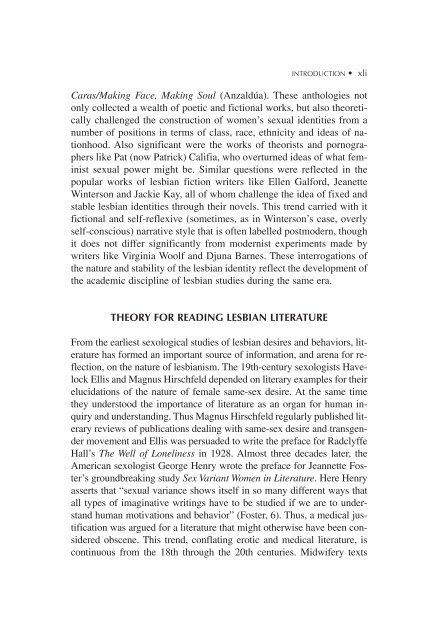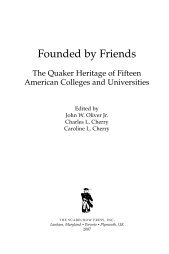Historical Dictionary of Lesbian Literature - Scarecrow Press
Historical Dictionary of Lesbian Literature - Scarecrow Press
Historical Dictionary of Lesbian Literature - Scarecrow Press
You also want an ePaper? Increase the reach of your titles
YUMPU automatically turns print PDFs into web optimized ePapers that Google loves.
Caras/Making Face, Making Soul (Anzaldúa). These anthologies not<br />
only collected a wealth <strong>of</strong> poetic and fictional works, but also theoretically<br />
challenged the construction <strong>of</strong> women’s sexual identities from a<br />
number <strong>of</strong> positions in terms <strong>of</strong> class, race, ethnicity and ideas <strong>of</strong> nationhood.<br />
Also significant were the works <strong>of</strong> theorists and pornographers<br />
like Pat (now Patrick) Califia, who overturned ideas <strong>of</strong> what feminist<br />
sexual power might be. Similar questions were reflected in the<br />
popular works <strong>of</strong> lesbian fiction writers like Ellen Galford, Jeanette<br />
Winterson and Jackie Kay, all <strong>of</strong> whom challenge the idea <strong>of</strong> fixed and<br />
stable lesbian identities through their novels. This trend carried with it<br />
fictional and self-reflexive (sometimes, as in Winterson’s case, overly<br />
self-conscious) narrative style that is <strong>of</strong>ten labelled postmodern, though<br />
it does not differ significantly from modernist experiments made by<br />
writers like Virginia Woolf and Djuna Barnes. These interrogations <strong>of</strong><br />
the nature and stability <strong>of</strong> the lesbian identity reflect the development <strong>of</strong><br />
the academic discipline <strong>of</strong> lesbian studies during the same era.<br />
THEORY FOR READING LESBIAN LITERATURE<br />
INTRODUCTION • xli<br />
From the earliest sexological studies <strong>of</strong> lesbian desires and behaviors, literature<br />
has formed an important source <strong>of</strong> information, and arena for reflection,<br />
on the nature <strong>of</strong> lesbianism. The 19th-century sexologists Havelock<br />
Ellis and Magnus Hirschfeld depended on literary examples for their<br />
elucidations <strong>of</strong> the nature <strong>of</strong> female same-sex desire. At the same time<br />
they understood the importance <strong>of</strong> literature as an organ for human inquiry<br />
and understanding. Thus Magnus Hirschfeld regularly published literary<br />
reviews <strong>of</strong> publications dealing with same-sex desire and transgender<br />
movement and Ellis was persuaded to write the preface for Radclyffe<br />
Hall’s The Well <strong>of</strong> Loneliness in 1928. Almost three decades later, the<br />
American sexologist George Henry wrote the preface for Jeannette Foster’s<br />
groundbreaking study Sex Variant Women in <strong>Literature</strong>. Here Henry<br />
asserts that “sexual variance shows itself in so many different ways that<br />
all types <strong>of</strong> imaginative writings have to be studied if we are to understand<br />
human motivations and behavior” (Foster, 6). Thus, a medical justification<br />
was argued for a literature that might otherwise have been considered<br />
obscene. This trend, conflating erotic and medical literature, is<br />
continuous from the 18th through the 20th centuries. Midwifery texts
















